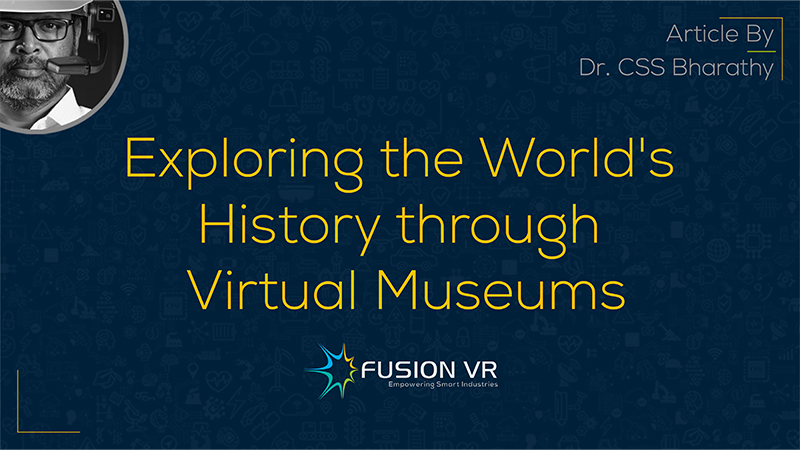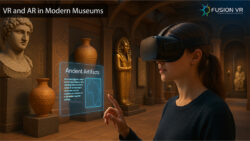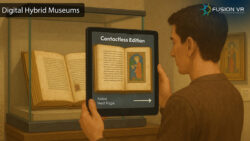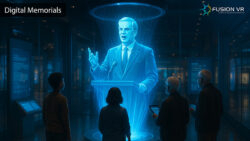The astonishing growth of new digital technologies, such as virtual reality and augmented reality, has ushered in a new age of cultural exploration and immersive experiences. With these developments one is coming to experience the dramatic rise of virtual museums. Here we are able to gain synergies with the rich heritage of traditional museums, the unparalleled capabilities and power of digital technologies leading to the development of virtual museums.
These virtual interactive museums provide a high quality visitor experience to everyone who walks through their portal’s doors. Virtual museum experiences offer a unique and accessible solution for people who wish to explore the treasures of art, history, and culture from the convenience of their home or office and also manage their other commitments more effectively.
We are here to explore the remarkable growth and significance of virtual museums in the recent decade. We would like to share their advantages, challenges, and the potential to transform how we access, use and enjoy the vast treasure trove of cultural, scientific and artistic items of human civilisation. Let’s take a step back and peek into the past on how virtual museums have evolved and what the future promises to mankind.
Virtual museums have evolved from simple online galleries to providing sophisticated immersive experiences. There are both virtual museums and those that provide the VR museum experience. Let’s explore this further. In the beginning, the virtual museums provided mainly digitized images with detailed descriptions of various items and artifacts.
This progressed into providing virtual walkthroughs into real museums with digital navigation tools for people to visit museums over the internet and enabling them to remotely view their collections. With the rapid growth of Industry 4.0 digital technologies, we have virtual museums that now offer immersive 3D environments, exciting interactive displays, and amazing virtual reality experiences.
They have become VR experience centres for museums enabling an immersive experience to enjoy the treasures of the past and present, allowing visitors to navigate virtual museum halls, get up close and personal to artifacts and provide a unique personal experience.
Advantages of Virtual Museums in Promoting Accessibility and Cultural Exploration
Let’s see how virtual museums promote accessibility and Inclusivity. This is probably one of the more prominent advantages of virtual museums. Traditional museums impose certain limitations on the populations that are interested in visiting them. Most museums are only available in major cities which cater only to those who can afford or have the opportunity to visit them.
They are located in structures which have physical capacity limitations which leads to longer wait times for people to obtain a thorough museum experience. Also traditional museums pose problems for the disabled population as they usually are not designed to provide ramps and elevators for safe wheelchair access. Virtual museums are enabling people from all over the world, breaking down these barriers to have a wholesome museum experience from the comfort of their homes.
Virtual museums are therefore more inclusive than traditional museums as they provide access to all types of interested individuals across all age groups. Technology has wonderfully leveled the field and is delivering experiences that bring a broad spectrum of audiences to the museum. With the growth and affordability of devices such as smartphones, tablets and virtual reality headsets, the rise of virtual museums is virtually guaranteed.
Museums are also promoting cultural exploration through better preservation and conservation of global cultural treasures. In the traditional museum scenario, many museums collaborate among themselves to share their exhibits and conduct traveling exhibitions for the world to enjoy and experience them. This is a complex undertaking as they also have the risk of damaging these artifacts or them getting stolen or lost during transit.
When that happens, it becomes almost impossible to recover or restore these artifacts. In this context virtual museums and VR museums play a crucial role in enabling far flung audiences to experience a museum visit without incurring the above mentioned costs and risks. 3D scanning technologies accurately reconstruct these artifacts in digital mode and present them in virtual museums.
There are some artifacts like Leonardo Da Vinci’s The Last Supper which only a limited number of people can visit each day to stem its deterioration. The beauty of this painting and all its technical and artistic glory can be experienced if it is digitized and made accessible to visitors. This is probably the only way left to ensure better conservation of fragile artistic treasures. A vast digital network of museums can be established to allow better networking, sharing and delivery of high quality virtual museum experiences.
The Potential and Challenges of Virtual Museums
Education is a huge area of significance for virtual museums. The future of every nation is in the hands of the young generation. Museums provide an environment for young people to learn and appreciate the past and the achievements of their ancestors. They reinforce cultural values and provide the motivation for the present young generation to set its targets and achieve them.
Virtual museums provide the engagement needed for the digital generation using interactive exhibits and immersive experiences. VR-powered education is reported through various studies as highly engaging and faster than traditional pedagogical methods.
The retention of useful and essential information through virtual reality experiences is also very high. Incorporating virtual museum visits as part of the curriculum will favourably enhance all learning outcomes in educational institutions. Virtual museum visits can be undertaken at any time during a class to explain, highlight and motivate young minds. The virtual museum experience can be infused with gamification elements that make learning interesting and rewarding.
As with any technology or disruptive change, we recognise that virtual museums do have their share of challenges. This is more acute in less developed and developing countries where a digital divide and affordable access to technology exist. The connectivity may exist but at low bandwidths, and effective access is limited to only to a few who can afford it.
The multiple benefits that I have cited above may not materialise in poor and marginalised communities across the world. There are pockets of disadvantaged communities even in developed nations. The risk of corrupt individuals appropriating cultural treasures and attempting to gain economic benefits also exists. In the age of fake news and social media, misappropriation and misrepresentation of cultural icons and historical facts could also happen.
While we acknowledge the benefits and exhilarating experiences of the virtual museum, it may not fully replace the tangible experience that comes with traditional museums. Another facet is the ability to meet real people and enable valuable social interactions that could be limited to virtual museums. The user interface and user experience need to be intuitively designed to provide visitors with a quality virtual experience.
The future is still bright for virtual museums as it holds great potential to be beneficially exploited. The growth of virtual museums is continually enhanced by developments in virtual reality, augmented reality, and artificial intelligence. Virtual museums will eventually integrate emerging technologies like haptic feedback and multisensory interfaces and create more interesting and engaging virtual museum experiences.
The potential to integrate virtual and traditional museums is high, which would deliver hybrid experiences that provide the best of both worlds. As we progress, we will acquire the means to manage the challenges and maximise the benefits of virtual museums for the benefit of humanity by bridging the gaps between culture and technology and delivering a greater appreciation of our shared heritage by people of the global community.
Fusion VR is at the forefront of developing virtual reality museum experiences across the nation by partnering with private and governmental entities to deliver immersive and interactive experiences by applying digital technologies in museums. I encourage you to check out our offerings and services for the museums and corporate experience centres that deliver high-quality visitor experience. Reach out to us to realise your passion for driving change in the world of virtual museums.





